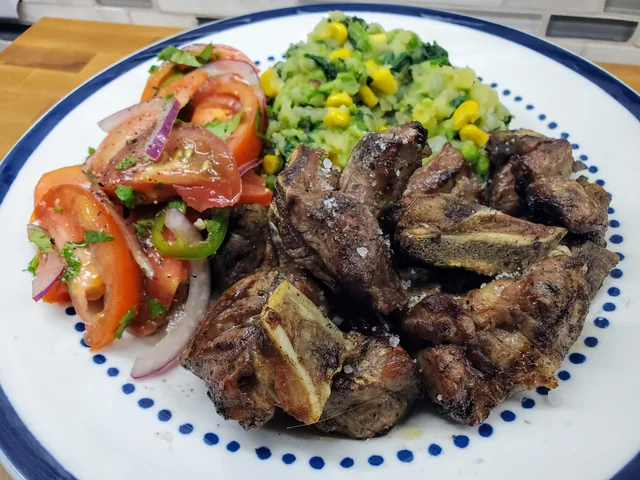wherearewegoing.net – Nyama choma, Swahili for “roasted meat” or “burnt meat,” is more than just a dish; it’s a cultural experience deeply ingrained in Kenyan and East African social life. This simple yet incredibly flavorful preparation of grilled meat, most often goat or beef, but sometimes chicken or fish, is a staple at gatherings, celebrations, and casual get-togethers. The smoky aroma of grilling meat, the lively conversations, and the shared enjoyment of nyama choma create a unique and unforgettable culinary tradition.
Origins and Cultural Significance
The practice of grilling meat over open flames has ancient roots, and nyama choma has evolved as a natural extension of pastoralist traditions in East Africa, where livestock plays a significant role in daily life. While its exact origins are difficult to pinpoint, nyama choma has become synonymous with Kenyan culture, representing hospitality, community, and celebration.
Nyama choma is often the centerpiece of social events, from family gatherings and birthday parties to weddings and national holidays. It’s a dish that brings people together, fostering a sense of camaraderie and shared enjoyment. The act of grilling and sharing nyama choma is a social ritual, with friends and family gathering around the grill, sharing stories, and enjoying the anticipation of the delicious meal to come.
Choosing the Meat: Goat, Beef, and More
While goat meat is arguably the most popular choice for nyama choma, beef is also widely enjoyed. Other meats, such as chicken ( kuku choma) and fish ( samaki choma), are also prepared using similar grilling methods.
- Goat Meat (Mbuzi Choma): Goat meat is favored for its rich flavor and slightly gamey taste. It is often considered the most authentic form of nyama choma.
- Beef (Ng’ombe Choma): Beef is a readily available and popular alternative, offering a different flavor profile and texture.
- Chicken (Kuku Choma): Chicken is a lighter option, often marinated before grilling to enhance its flavor.
- Fish (Samaki Choma): Fish, especially tilapia or other locally sourced varieties, is grilled whole or in fillets, often seasoned with spices and served with accompaniments like coconut rice.
Preparing Nyama Choma: A Simple Yet Skillful Process
The preparation of nyama choma is relatively simple, but achieving perfectly grilled meat requires skill and attention to detail.
- Preparing the Meat: The meat is typically cut into large pieces, often bone-in, to prevent it from drying out during grilling. Minimal seasoning is used, usually just salt, allowing the natural flavor of the meat to shine through. Some people may marinate the meat with lemon juice, garlic, or other spices, but this is less common for traditional nyama choma.
- Setting up the Grill: A charcoal grill or open fire is used for grilling. The coals are allowed to burn down to a medium heat, creating a consistent and even cooking temperature.
- Grilling the Meat: The meat is placed directly on the grill grates and cooked slowly, turning it regularly to ensure even cooking on all sides. The grilling time varies depending on the type and thickness of the meat.
- Checking for Doneness: The meat is considered done when it is cooked through but still juicy and tender. A simple way to check for doneness is to pierce the meat with a fork or knife; the juices should run clear.
Serving and Accompaniments: Simple and Satisfying
Nyama choma is typically served simply, allowing the flavor of the grilled meat to be the star of the show.
- Kachumbari: A fresh and tangy salad made with chopped tomatoes, onions, and chili peppers. This is the most common accompaniment to nyama choma, providing a refreshing contrast to the rich meat.
- Ugali: A staple East African dish made from maize flour. Ugali provides a starchy base that soaks up the juices from the meat.
- Mukimo: A mashed potato and green vegetable dish, sometimes served as an alternative to ugali.
- Roasted Potatoes or Bananas: These can be grilled alongside the meat or served as a separate side dish.
The Nyama Choma Experience: More Than Just a Meal
Nyama choma is more than just food; it’s a social event. The experience is often as important as the meal itself. Gathering around the grill, sharing stories, and enjoying the anticipation of the delicious meat creates a unique and memorable experience. The informal and communal nature of nyama choma makes it a perfect way to connect with friends and family.
Regional Variations
While the basic concept of nyama choma remains consistent across Kenya and East Africa, there can be regional variations in the preparation and accompaniments.
- Coastal regions may incorporate more seafood into their nyama choma, grilling fish or other seafood alongside the meat.
- Some regions may use different types of wood for grilling, imparting unique smoky flavors to the meat.
- Variations in spice rubs or marinades may also exist.
Nyama Choma’s Enduring Appeal
Nyama choma’s enduring popularity in Kenya and East Africa stems from its simplicity, flavor, and cultural significance. It is a dish that embodies the spirit of the region, representing hospitality, community, and shared culinary experiences. From roadside stalls to upscale restaurants, the aroma of grilling nyama choma continues to be a testament to its enduring appeal.
